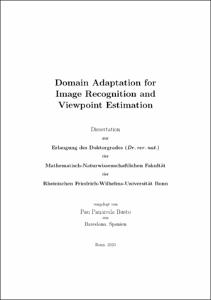Domain Adaptation for Image Recognition and Viewpoint Estimation

Domain Adaptation for Image Recognition and Viewpoint Estimation

| dc.contributor.advisor | Gall, Jürgen | |
| dc.contributor.author | Panareda Busto, Pau | |
| dc.date.accessioned | 2020-09-08T13:12:04Z | |
| dc.date.available | 2020-09-08T13:12:04Z | |
| dc.date.issued | 08.09.2020 | |
| dc.identifier.uri | https://hdl.handle.net/20.500.11811/8582 | |
| dc.description.abstract | Image-based recognition tasks require in their training phase large amounts of data to capture as much visual traits as possible. In many situations, however, the collection of image data implies a tedious effort or, even worse, the test scenarios remain unknown. On top of that, the labelling process is very time consuming, expensive and prone to error. This means that the access to fast, cheap and accurate labelled data arises as ones of the main challenges in classification problems. In this work, we present three major contributions that pursue the attenuation of these issues in image recognition and viewpoint estimation problems. Overall, the main goal is reducing the amount of data collection and labelling effort.
In order to achieve that, we firstly introduce a novel domain adaptation method that allows datasets from different domains to take part in the training process and contribute to improved classification accuracies. We also revise the unrealistic setting of domain adaptation evaluation datasets and introduce open set domain adaptation for target domains that also contain irrelevant samples that belong to unknown classes. Then, we also propose an optimisation process for fine viewpoint labelling and use synthetic data to refine viewpoints that are coarsely annotated by humans in real images. To this end, due to the differences between the real and the synthetic data, we apply domain adaptation to align both domains and improve the viewpoint refinement. The results have shown that 3D generated models can be successfully used to refine labels in real images. We finally present an end-to-end multi-task neural network that jointly trains viewpoints and keypoints of rigid objects. We also reinforce the real training data with a novel synthetic dataset that contains annotations for both problems. The experiments show that the proposed approach successfully exploits this implicit correlation between the tasks and outperforms previous techniques that are trained independently. | en |
| dc.language.iso | eng | |
| dc.rights | In Copyright | |
| dc.rights.uri | http://rightsstatements.org/vocab/InC/1.0/ | |
| dc.subject | Bildverarbeitung | |
| dc.subject | Objekterkennung | |
| dc.subject | Posenschätzung | |
| dc.subject | Klassifikator | |
| dc.subject | Adaptierung | |
| dc.subject.ddc | 004 Informatik | |
| dc.title | Domain Adaptation for Image Recognition and Viewpoint Estimation | |
| dc.type | Dissertation oder Habilitation | |
| dc.publisher.name | Universitäts- und Landesbibliothek Bonn | |
| dc.publisher.location | Bonn | |
| dc.rights.accessRights | openAccess | |
| dc.identifier.urn | https://nbn-resolving.org/urn:nbn:de:hbz:5-59574 | |
| ulbbn.pubtype | Erstveröffentlichung | |
| ulbbnediss.affiliation.name | Rheinische Friedrich-Wilhelms-Universität Bonn | |
| ulbbnediss.affiliation.location | Bonn | |
| ulbbnediss.thesis.level | Dissertation | |
| ulbbnediss.dissID | 5957 | |
| ulbbnediss.date.accepted | 02.09.2020 | |
| ulbbnediss.institute | Mathematisch-Naturwissenschaftliche Fakultät : Fachgruppe Informatik / Institut für Informatik | |
| ulbbnediss.fakultaet | Mathematisch-Naturwissenschaftliche Fakultät | |
| dc.contributor.coReferee | Akata, Zeynep |
Dateien zu dieser Ressource
Das Dokument erscheint in:
-
E-Dissertationen (4361)




